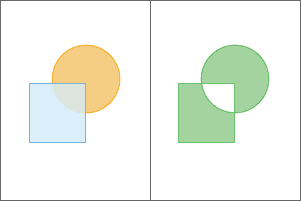
ST_SymDifference takes two geometry columns and returns a geometry column. The output column contains the
geometries that represent the portions of the input geometries that do not intersect. If one of the input geometry types is geometry, the output
type will be the same. For all other cases the result geometry type will be the same as the input geometry type with the
highest dimension.
| Function | Syntax |
|---|---|
| Python | sym |
| SQL | ST |
| Scala | sym |
For more details, go to the GeoAnalytics Engine API reference for sym_difference.
This function implements the OpenGIS Simple Features Implementation Specification for SQL 1.2.1.
Python and SQL Examples
from geoanalytics.sql import functions as ST, Point, Polygon
df = spark.createDataFrame([(Point(8,8), Polygon([[[0,0],[10,0],[10,10],[0,10]]]),)], ["point", "polygon"])
df.select(ST.sym_difference(ST.buffer("point", 5), "polygon")).st.plot()
Scala Example
import com.esri.geoanalytics.geometry._
import com.esri.geoanalytics.sql.{functions => ST}
import org.apache.spark.sql.{functions => F}
case class GeometryRow(point: Point, polygon: Polygon)
val data = Seq(GeometryRow(Point(8, 8), Polygon(Point(0, 0), Point(0, 10), Point(10, 10), Point(10, 0))))
val df = spark.createDataFrame(data)
.select(ST.symDifference(ST.buffer($"point", 5), $"polygon").alias("sym_difference"))
.withColumn("difference_area", F.round(ST.area($"sym_difference"),3))
df.show()+--------------------+---------------+
| sym_difference|difference_area|
+--------------------+---------------+
|{"rings":[[[13,8]...| 92.35|
+--------------------+---------------+Version table
| Release | Notes |
|---|---|
1.0.0 | Python and SQL functions introduced |
1.5.0 | Scala function introduced |